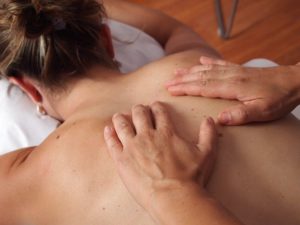Hier eine Übersetzung ins Deutsche (mit Dank an Matthias Jamin.)
I came into the world of Tantric massage sort of sideways.
The man I had been seeing for some months was planning to attend a 10-day Tantric massage therapist training and asked me to join him. I liked the idea of sharing Tantric massage skills and intimacy with my partner, and I knew from experience after multiple certifications that a practitioner training goes to a depth that simple workshop participation does not. As someone who loves depth, intensity and transformation, this appealed to me.

My lover and I were informed that we would not be allowed to work with each other as it was a therapist training. That made sense, but I imagined it would be challenging to attend as a couple and yet not work together, and that both of our relational attachment wounding and unfulfilled attachment needs would stir. Even so, I had confidence that our sensate intimacy, the safe harbor of the mutual caring and compassion, and foundation of respectful relatedness, would hold us well. And during those ten days, it did, even if it was sometimes excruciating.
At the time, I knew essentially nothing about Tantra, neo-Tantra or Tantric massage, except for my experience with Tibetan Buddhism, and having gone for one massage (pleasurable!) in order to decide whether or not to sign on for these 10 days. In other words, I did not know enough about neo-Tantra to consider the impact of practices that engage and activate the sensate self and the brain’s limbic system (emotions, personal relational attachment stories, somatic memories) – everything that Tantric massage is meant to activate – and I did not consider whether or not this teacher would provide safety and support for emotional triggers and integration in the participants. (Side note: those with secure attachment style will have a very different experience with Tantric massage and the foundations of “crazy wisdom” Tantra than someone with an anxious, avoidant or disorganized attachment style. How they digest the experience will vary accordingly, as well.)
Fortunately for me, my entry to Tantric massage did not happen before knowing about the indicators of traumatic stress in the nervous system or understanding my own attachment wounding and the impact of energy interactions. Unfortunately, this Tantric massage training would not teach how to recognize our own or a client’s somatic limits or overwhelm, nor the energetic impact and emotional attachment dynamics after Tantric massage. The energy and emotions activated daily were never intentionally processed during the training (yoga and the sauna were supposed to ‘burn that off’), leaving many with a lot to digest and integrate.
As it turned out, I would never have imagined the level of unethical use of power and fallout I would witness and experience in the workshop as well as the months that followed. During the workshop, the teacher seemed to use his position as Tantric master to profit off the energy of the females in the group, distance-inducing orgasms, gas lighting women into his bed or sexualizing them in other ways (such as a smack on the ass at lunch). When I returned home, not only did I find my energy in a chaos from the extreme activation without integration, but I felt shattered, exhausted, polluted – and on top of that, days after returning home and on the heels of his beautiful declarations of love, my boyfriend suddenly broke up with me. I heard from several peers that others had trouble functioning, experiencing loss of previous stability and ability to resource themselves, lives falling apart as they sorted their confusion. Despite powerful and liberating experiences in the massages that took place, many of us came out feeling unwell, wondering, is Tantra healing? Re-traumatizing? Or both? And in Tantric massage, when is it important to tend to the injuries of body, person, energy and soul?
If we truly embrace Tantra, then we know that all life experiences are valid and can serve our personal process – but where is the line between healthy and unhealthy practice? Polarity, dark and light, pleasure and pain, are all part of the human experience; and Tantra is the loving weave of all aspects of consciousness into One. In ultimate consciousness, there is no value judgment, no good, no bad, and no right or wrong. But in no way should these tenets be considered synonymous with „Therefore I don’t have to care,“ or „That’s just their karma.“
We learned a very good massage method in the training, and for most of us, deep and powerful healing moments were a part of the experience. But we learned next to nothing about how to deal with injuries to body and soul. Instead, we were told, “As long as you consecrate, you’ll be safe.”

As much as it would be wonderful if we could eliminate toxic teachers and therapists, we can’t; and damage might not even be intentional. Reality is, some of us come into Tantra more wounded and vulnerable than others. We don’t all have the same level of assertiveness skills available to us when needed (even if we are all technically adults), and individual trauma history and attachment wounding impact how we show up and digest our experiences. In order to get the potentially extraordinary benefits of Tantric massage, sufficient self-knowledge and the ability to honor our limits are key. Ideally, teachers and therapists are attuned to a client’s capacity, operate with compassion and the intention to empower the individual, but ultimately, the only true seat of power is in the sovereign empowerment of the self. 100% self-responsibility means 100% power to influence our experience: knowing our own developmental trauma, vulnerability and limits, and felt sense of “not ok,” can help us stay clear of further wounding to body and soul, as well as guide us to heal.
Text: Annicka Henttonen
email Annicka at Awaken.Love.Bliss@gmail.com









